Cane (23 page)
Authors: Jean Toomer

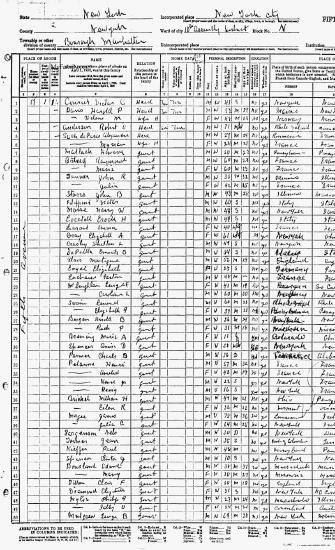
1930 census
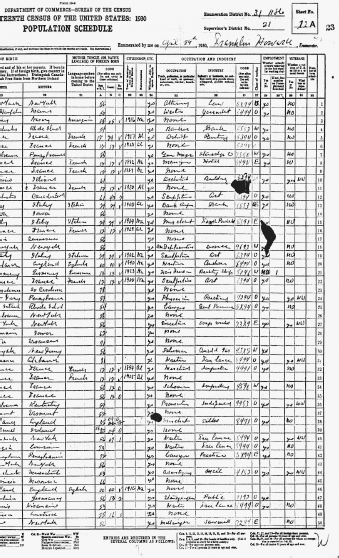

Detail of 1930 census.
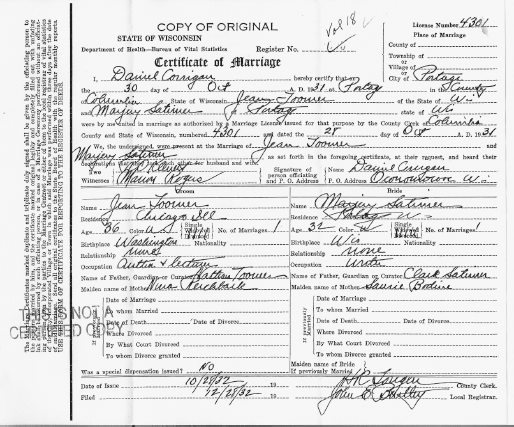
1931 marriage certificate.
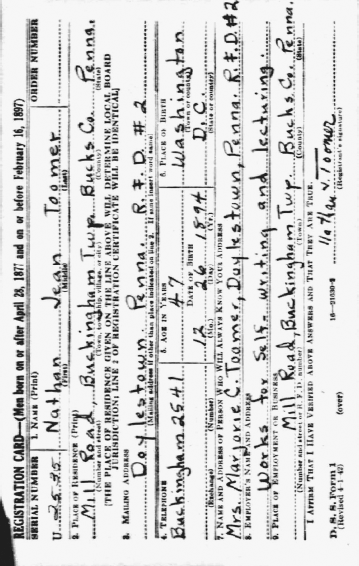
Draft registration, April 24, 1942.
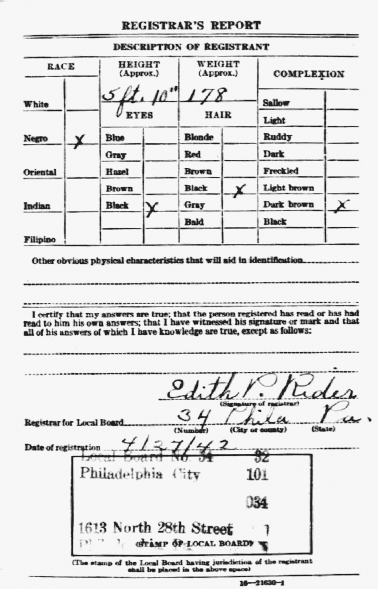
1.
Jean Toomer, “The Cane Years,” in
The Wayward and The Seeking: A Collection of Writings by Jean Toomer
, ed. Darwin T. Turner (Washington, D.C.: Howard University Press, 1980), 123.
2.
Perhaps the earliest scholar to query Toomer’s relationship to the writers of the “Lost Generation” and the New Negro movement or Harlem Renaissance was Robert A. Bone in
The Negro Novel in America
(1958). Since then Toomer’s relationship to the communities of writers who collectively constitute the various forms of American modernism has been examined by Rudolph P. Byrd, Charles T. Davis, Ann Douglas, Richard Eldridge, Genevieve Fabre, Maria Farland, Michel Feith, Alice P. Fisher, Karen S. Ford, S. P. Fullwinder, Henry Louis Gates, Jr., Jane Goldman, Nathan Grant, Leonard Harris, Mark Helbling, George Hutchinson, Robert B. Jones, Cynthia R. Kerman, Catherine G. Kodat, Victor Kramer, Vera Kutzinski, Charles R. Larson, Nellie Y. McKay, Charles Molesworth, Arnold Rampersad, Frederick L. Rusch, Mark A. Sanders, Charles Scruggs, Robert B. Stepto, Alan Trachtenberg, Darwin T. Turner, Mark Whalan, and Jon Woodson, among other scholars.
3.
James G. Hollandsworth, Jr.,
The Louisiana Native Guards: The Black Military Experience During the Civil War
(Baton Rouge: Louisiana State University Press, 1995), 73.
4.
Ibid., 111.
5.
Ibid., 111. As a lawmaker, Pinchback sponsored civil rights legislation that granted blacks equal access in public transportation, business, and places of entertainment. He also introduced legislation in Louisiana’s 1879 constitutional convention that would establish a “university for the education of persons of color.” This legislation would lead to the establishment of Southern University in 1880. From 1883 to 1885, Pinchback served on the board of trustees of Southern University. See pp. 108 and 115 in Hollandsworth’s
The Louisiana Native Guards.
6.
The Wayward and the Seeking,
23–24.
7.
Barbara Foley, “Jean Toomer’s Washington and the Politics of Class: From ‘Blue Veins’ to Seventh-street Rebels,”
Modern Fiction Studies
42.2 (1996): 298.
8.
Ibid., 313.
9.
The Wayward and the Seeking,
24.
10.
Ibid., 25.
11.
Ibid., 35–36.
12.
Ibid., 30.
13.
Ibid., 17.
14.
Ibid., 124.
15.
Ibid., 124.
16.
Ibid., 124.
17.
Kent Anderson Leslie and Willard B. Gatewood, Jr., “‘This Father of Mine…a Sort of Mystery’: Jean Toomer’s Georgia Heritage,”
The Georgia Historical Quarterly
LXXVII. 4 (Winter 1993): 793.
18.
Ibid., 790.
19.
Ibid., 798.
20.
Ibid., 794.
21.
Ibid., 789.
22.
The Lives of Jean Toomer: A Hunger for Wholeness
(Baton Rouge: Louisiana State University Press, 1987), 26.
23.
The Wayward and the Seeking,
33.
24.
The Lives of Jean Toomer,
28.
25.
Ibid., 28.
26.
Ibid., 28.
27.
Ibid., 35.
28.
Ibid., 35.
29.
Ibid., 101.
30.
For Toomer’s portrait of his father Nathan Toomer see
The Wayward and the Seeking,
32–33.
31.
The Wayward and the Seeking,
34.
32.
See
Jean Toomer’s Racial Self-Identifcation,
lxvi.
33.
The Lives of Jean Toomer,
2 7.
34.
“‘This Father of Mine…a Sort of Mystery’: Jean Toomer’s Georgia Heritage,” 802–809.
35.
The Lives of Jean Toomer,
85.
36.
The Wayward and the Seeking
, 41–42.
37.
Ibid., 42.
38.
Ibid., 42.
39.
Ibid., 44.
40.
Ibid., 45, 48.
41.
Ibid., 45.
42.
Ibid., 46.
43.
Ibid., 45.
44.
The Lives of Jean Toomer
, 36.
45.
The Wayward and the Seeking
, 47.
46.
Ibid., 47.
47.
James Weldon Johnson,
Along This Way
(New York: Penguin Books, 1933; 1990), 66.
48.
Ibid., 66.
49.
Darwin Turner,
The Wayward and the Seeking
(Washington, D.C.: Howard University Press, 1980), 91. Toomer “formed and formulated” his racial position in the summer of 1914. This racial position is set forth in “Outline of an Autobiography,” which Toomer wrote, according to Darwin Turner, between 1931 and 1932. Toomer claims that as a student at the University of Wisconsin that he “had no use” for his racial position because the “question [of race] was never raised.” He contradicts himself here for in a later section of his autobiography he recounts the experience of having to contend with the campus rumor that he was a “Hindu” and an “Indian,” as well as the racism of a white male classmate. See pp. 95–96 of
The Wayward and the Seeking.
50.
The Wayward and the Seeking
, 84.
51.
Ibid., 84.
52.
Ibid., 84.
53.
Ibid., 85.
54.
Ibid., 84.
55.
Ibid., 85.
56.
Ibid., 86.
57.
Ibid., 93.
58.
Ibid., 92.
59.
Ibid., 93.
60.
Jose Vasconcelos,
The Cosmic Race: A Bilingual Edition
(Baltimore: The Johns Hopkins University Press, 1997), 3.
61.
Ibid., for Vasconcelos the terms “the ffth race,” “synthetic race,” “definitive race,” and “cosmic race” are fungible.
The Cosmic Race
3, 7, 9, 18–19, 40.
62.
Ibid., 20.
63.
Ibid., 38.
64.
Ibid., 35.
65.
Ibid., 35.
66.
Ibid., 39.
67.
Ibid., 40.
68.
In her article “‘A Small Man in Big Spaces’: The New Negro, the Mestizo, and Jean Toomer’s Southwestern Writing,” Emily Lutenski asserts “there is no clear evidence that Toomer used Vasconcelos as a source when studying the Southwest. Regardless, there are clear parallels between Toomer’s and Vasconcelos’ writings.”
MELUS
33. 1 (Spring 2008) See this volume, p. 417.
69.
This was translated as
The Masters and the Slaves
in 1946.
70.
This was translated as
Cuban Counterpoint? Tobacco and Sugar
in 19 47.
71.
Zora Neale Hurston, “How It Feels to Be Colored Me,” in
I love myself when I am laughing…and then again when I am looking mean and impressive: A Zora Neale Hurston Reader
, edited by Alice Walker, with an introduction by Mary Helen Washington (Old Westbury, NY: Feminist Press, 1979), 154.
72.
W. E. B. Du Bois, “The Conservation of Races,” in
W. E. B. Du Bois: Writings,
ed. Nathan Huggins (New York: Library of America, 1986), 822.
